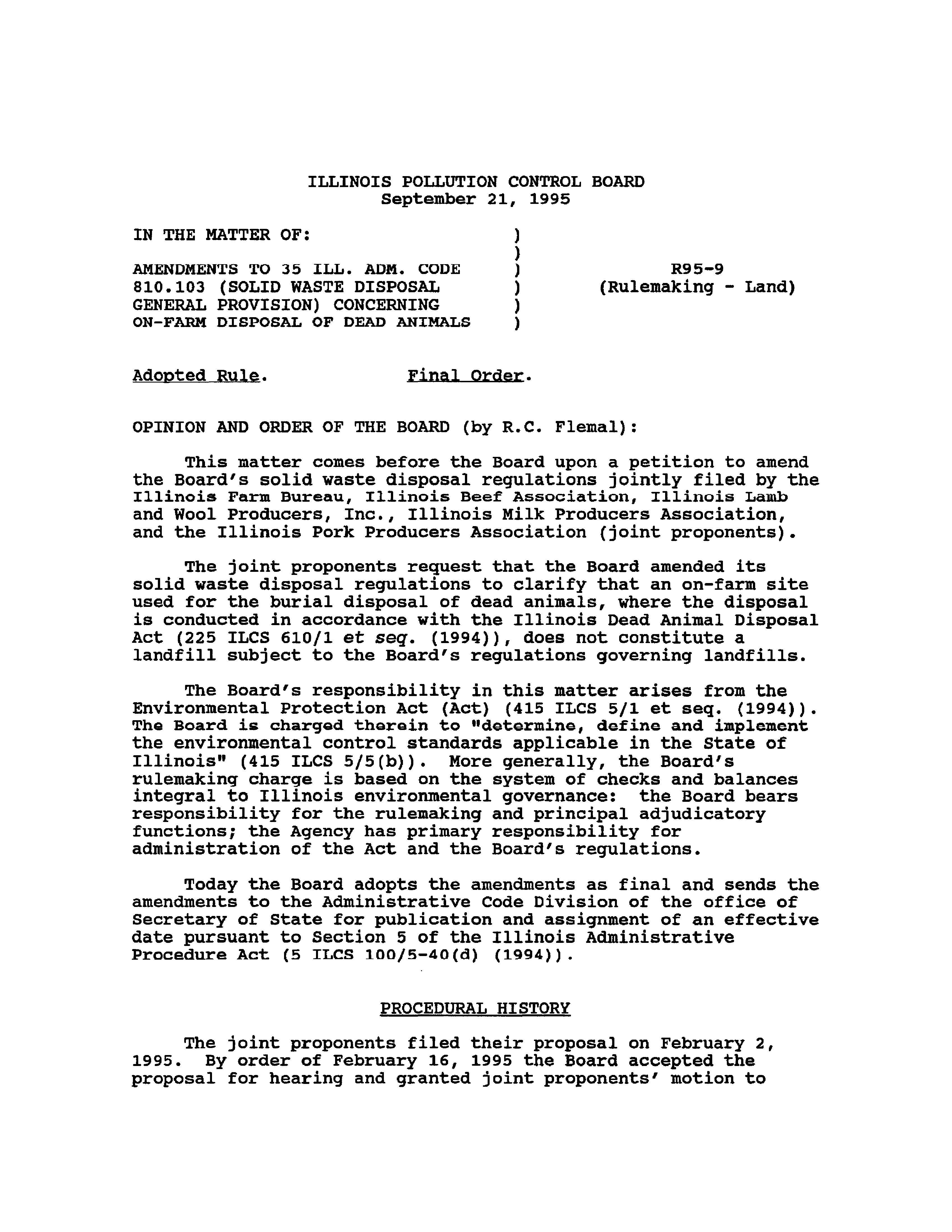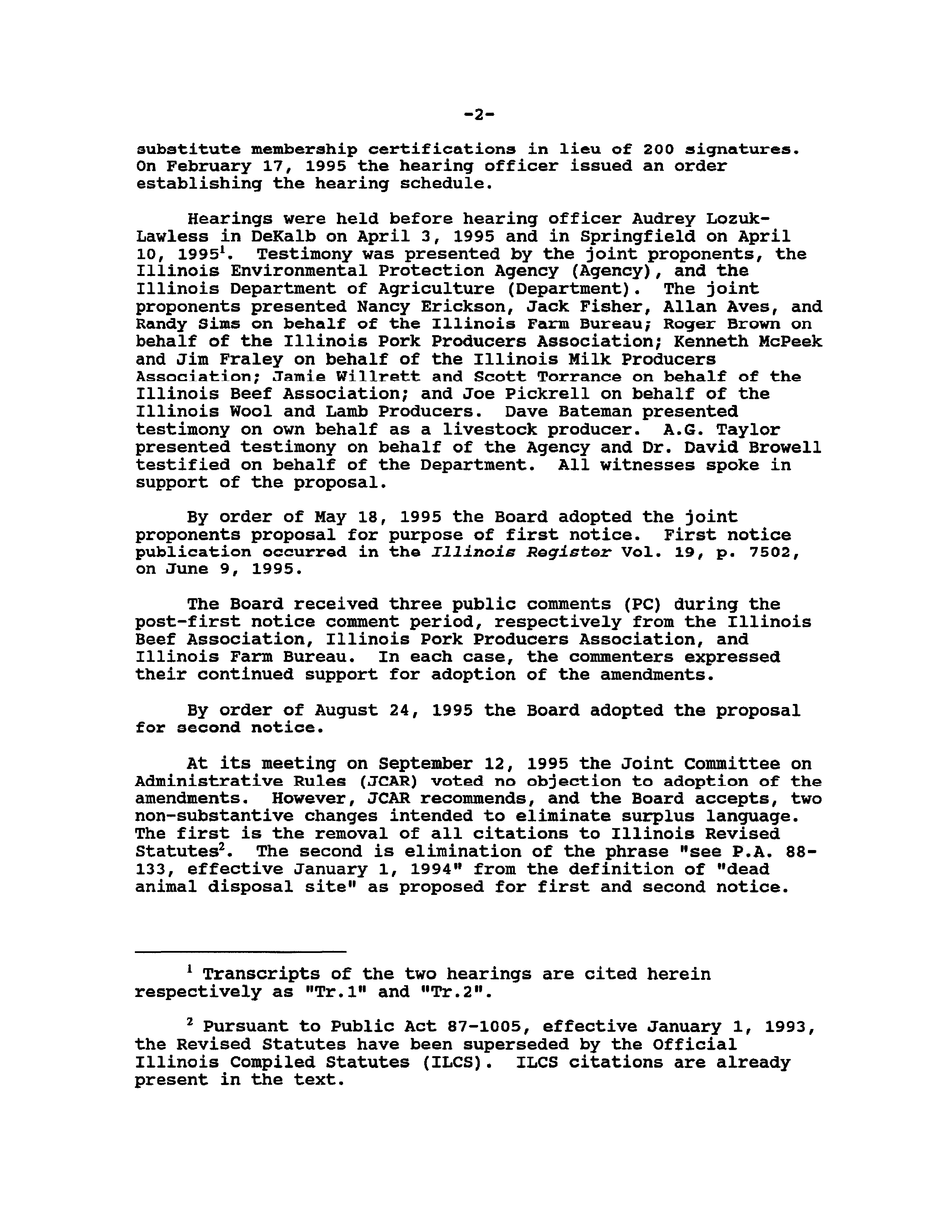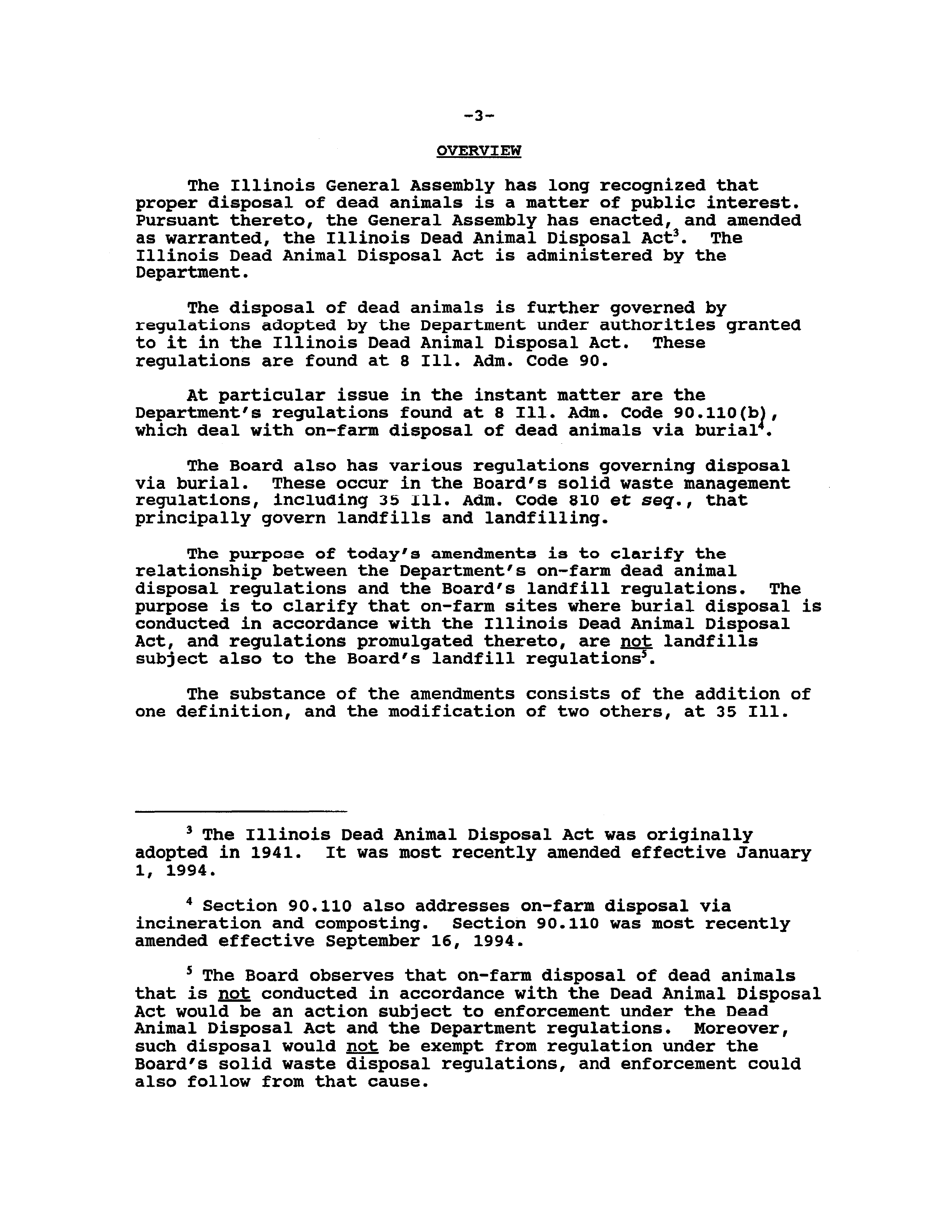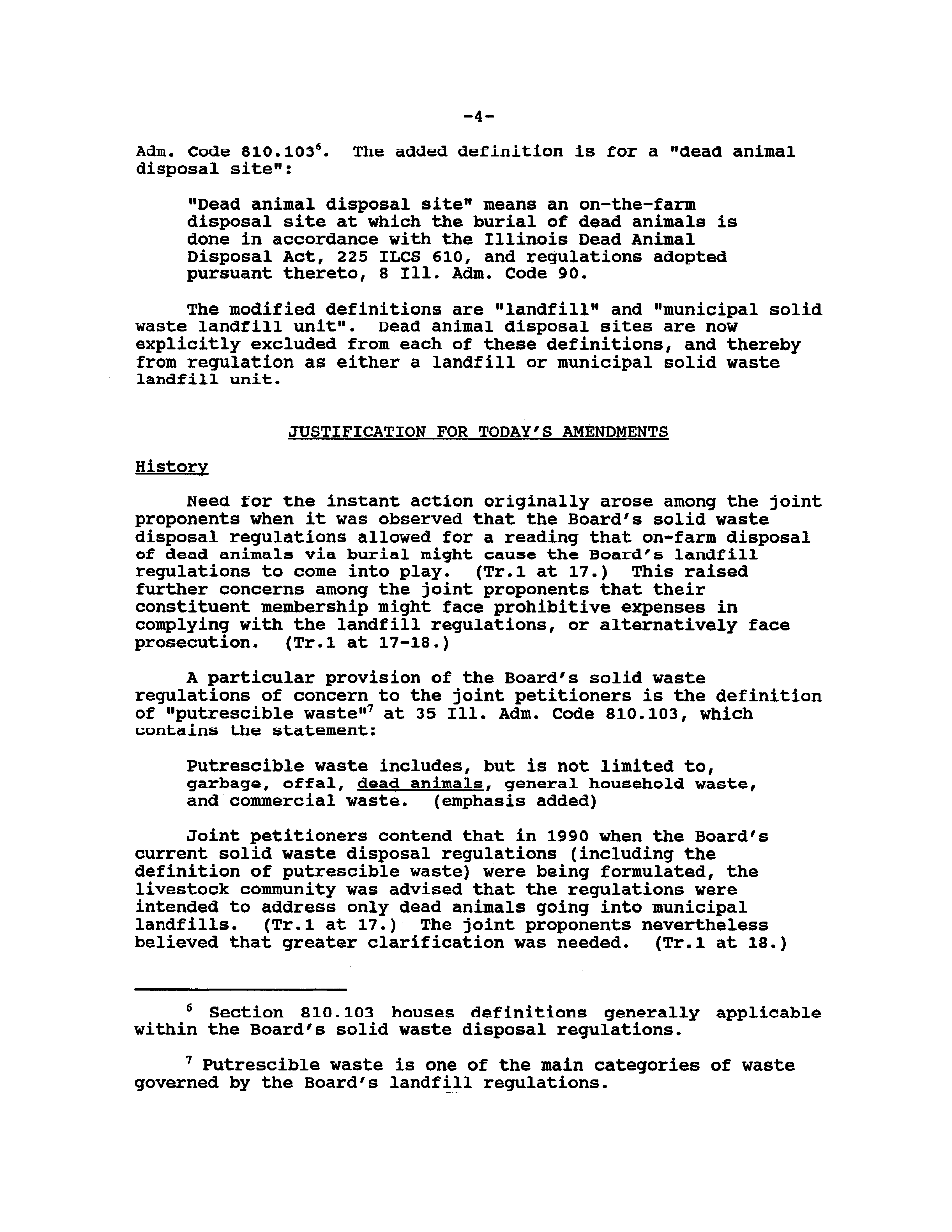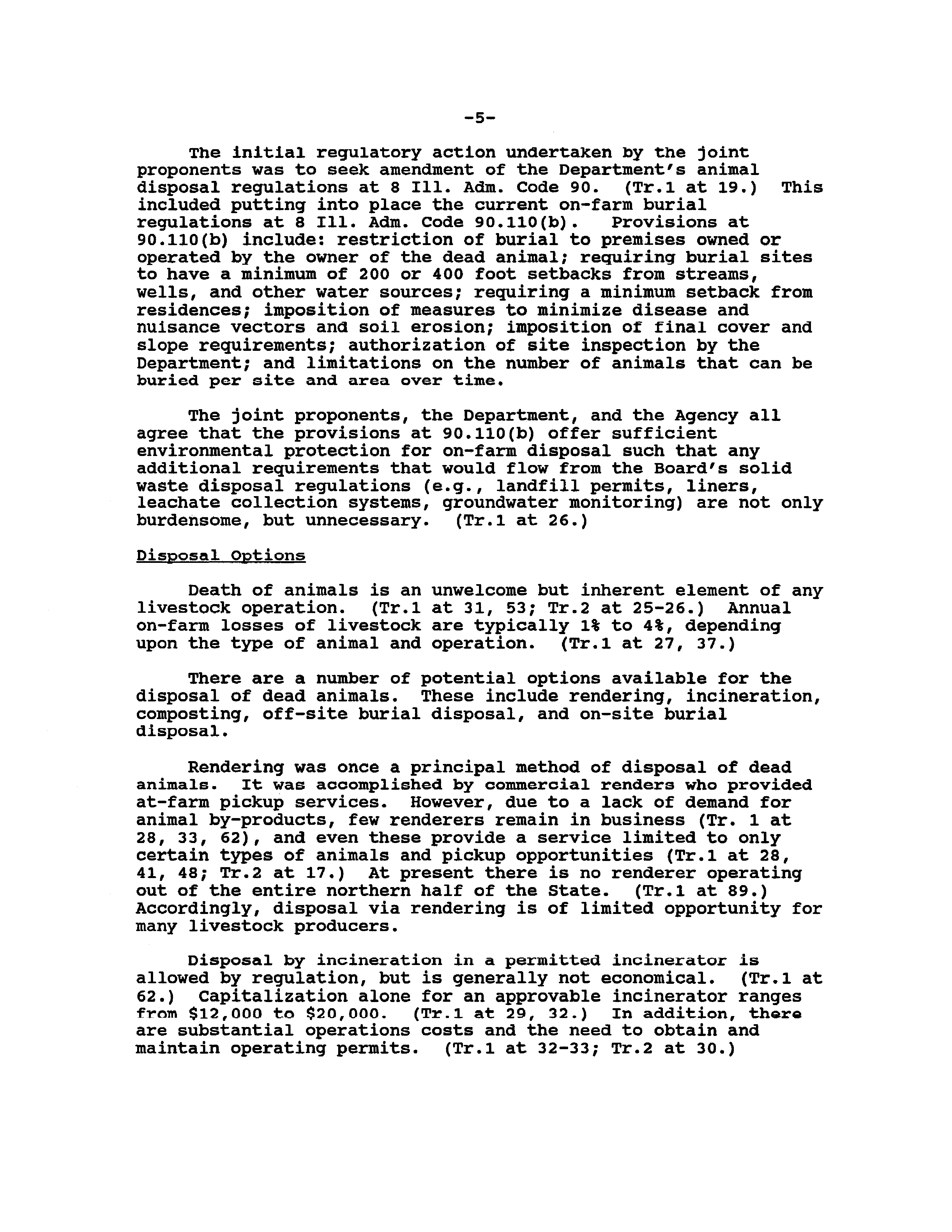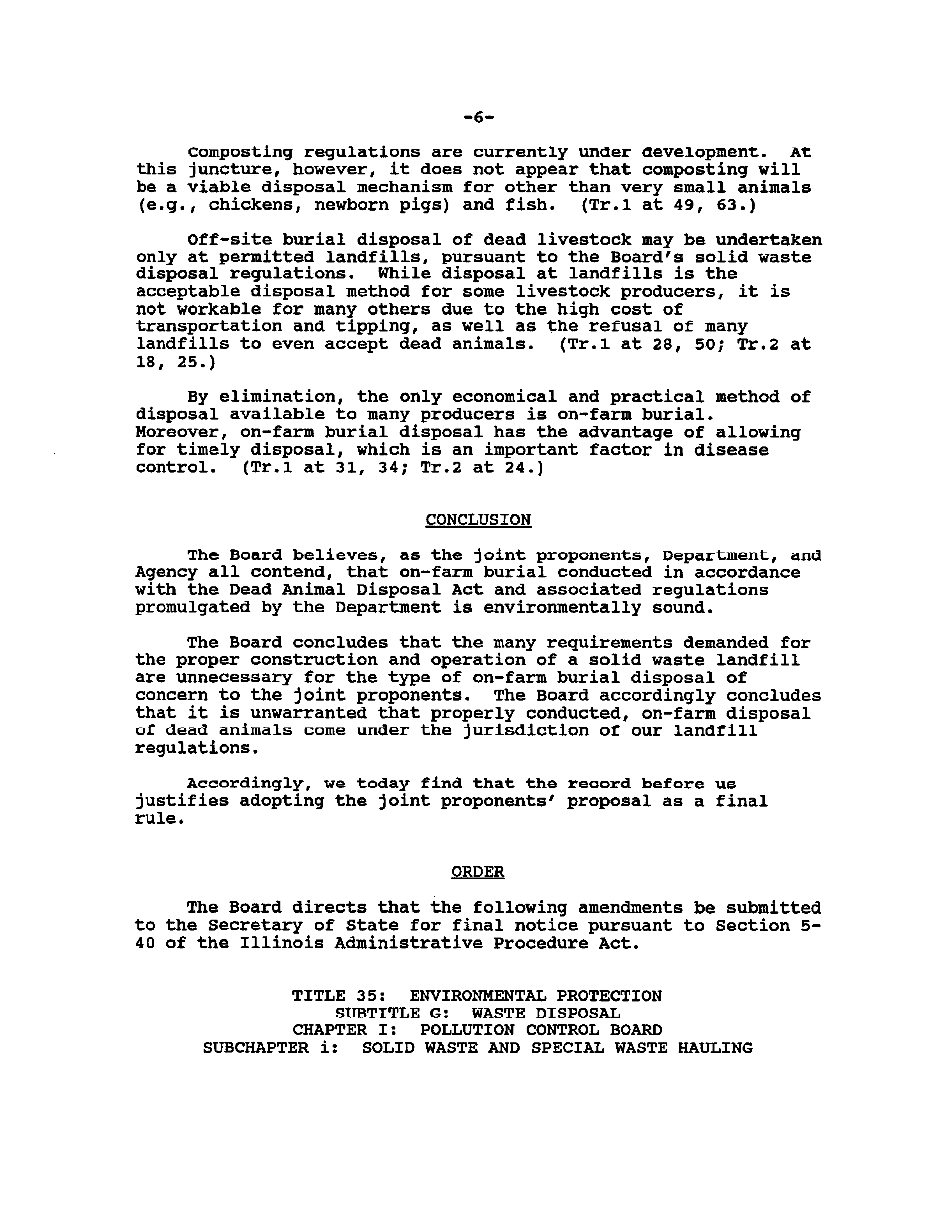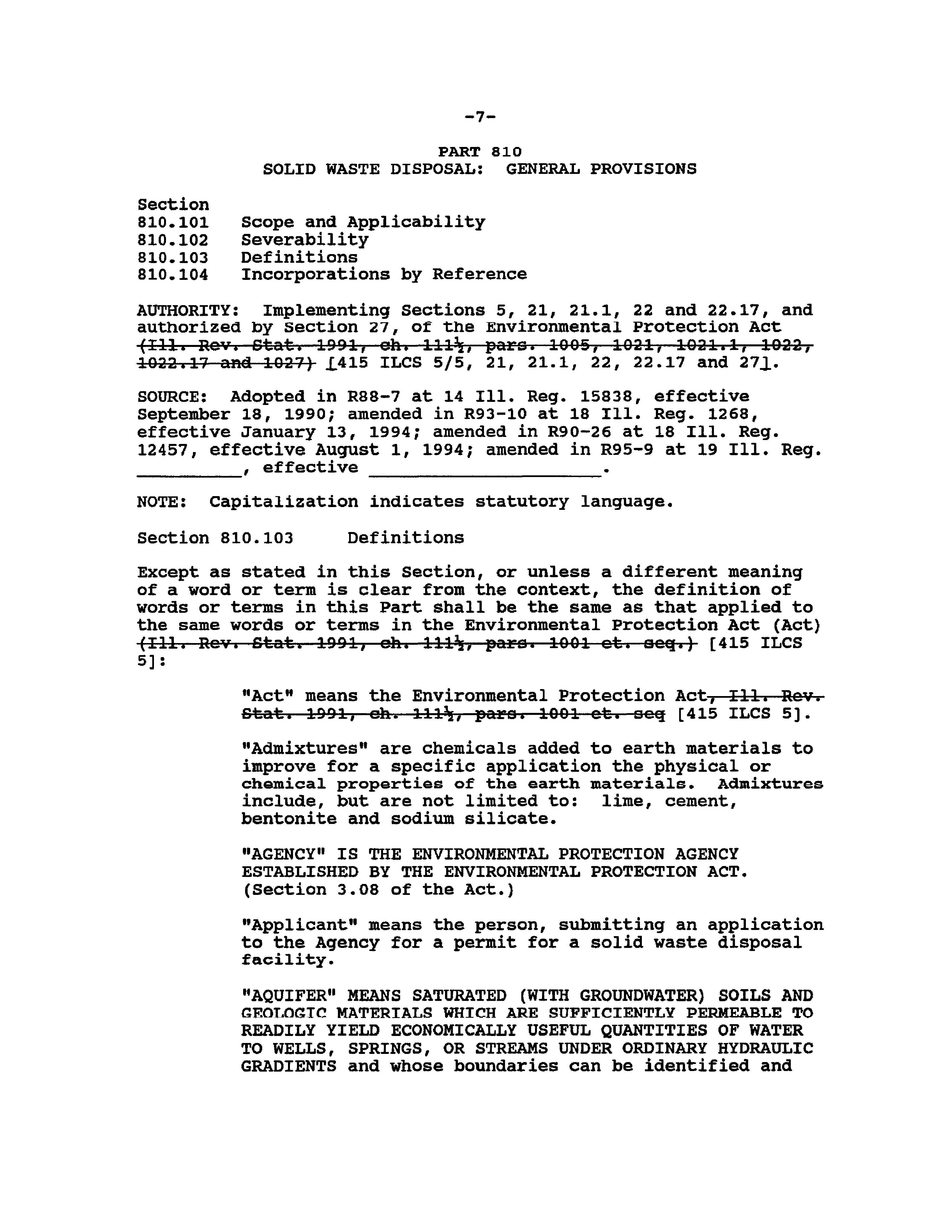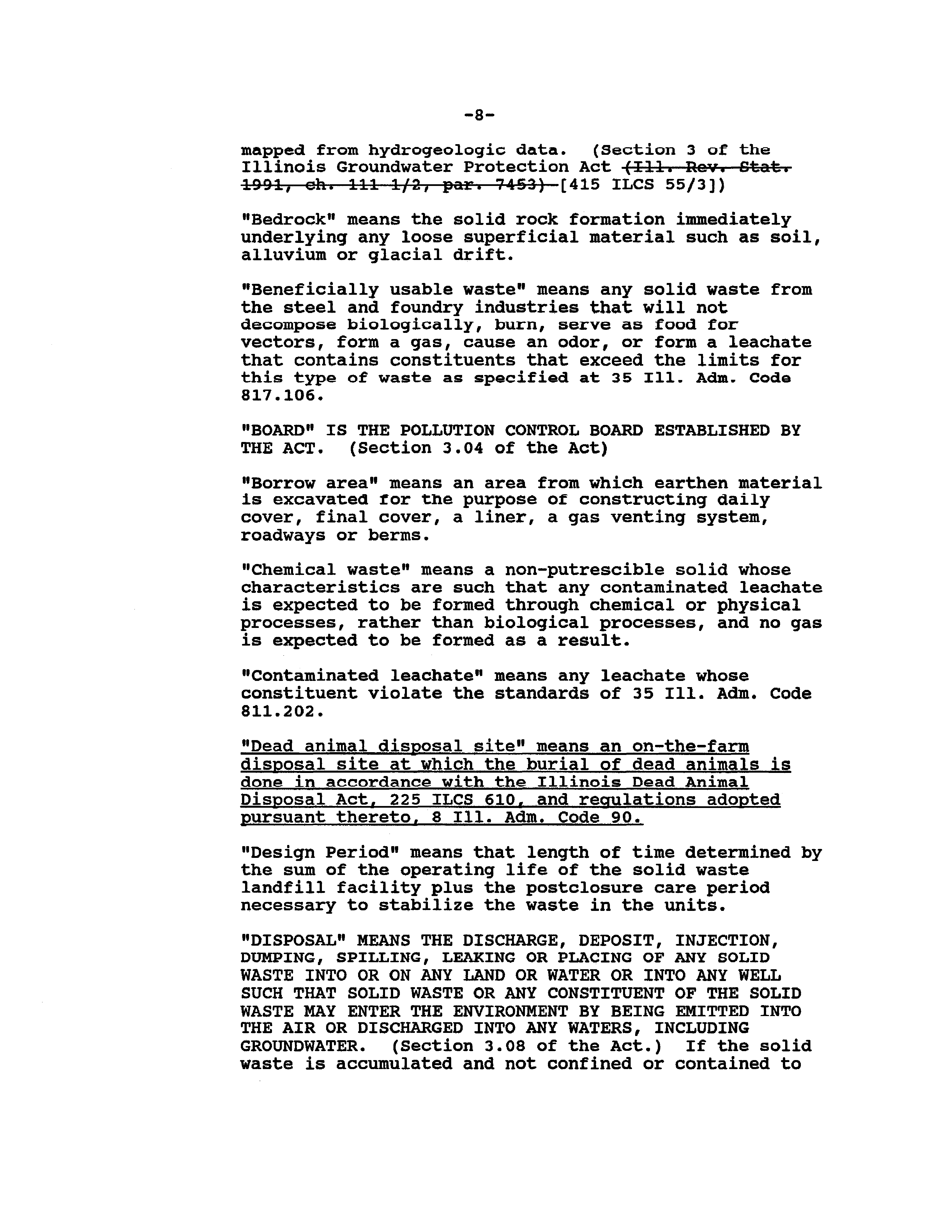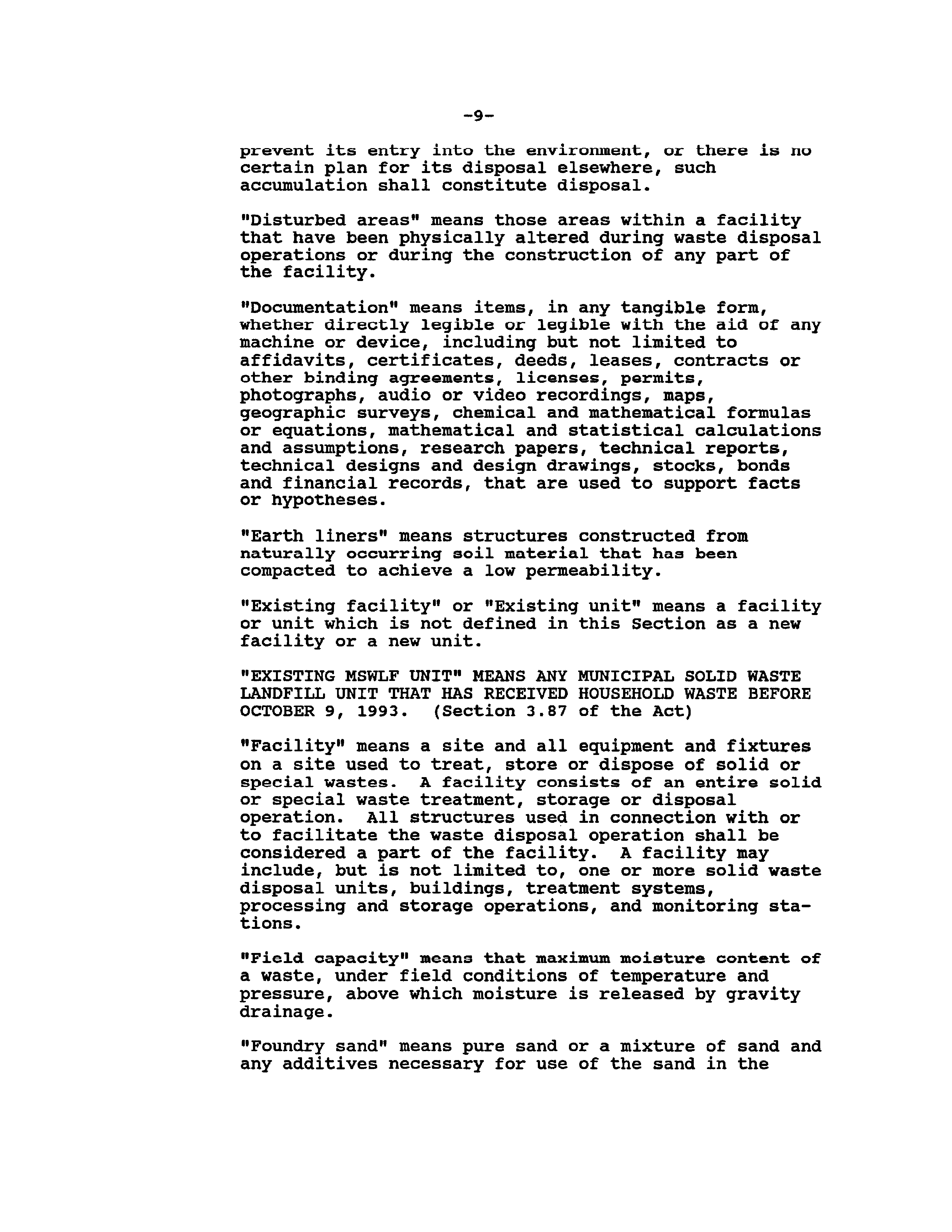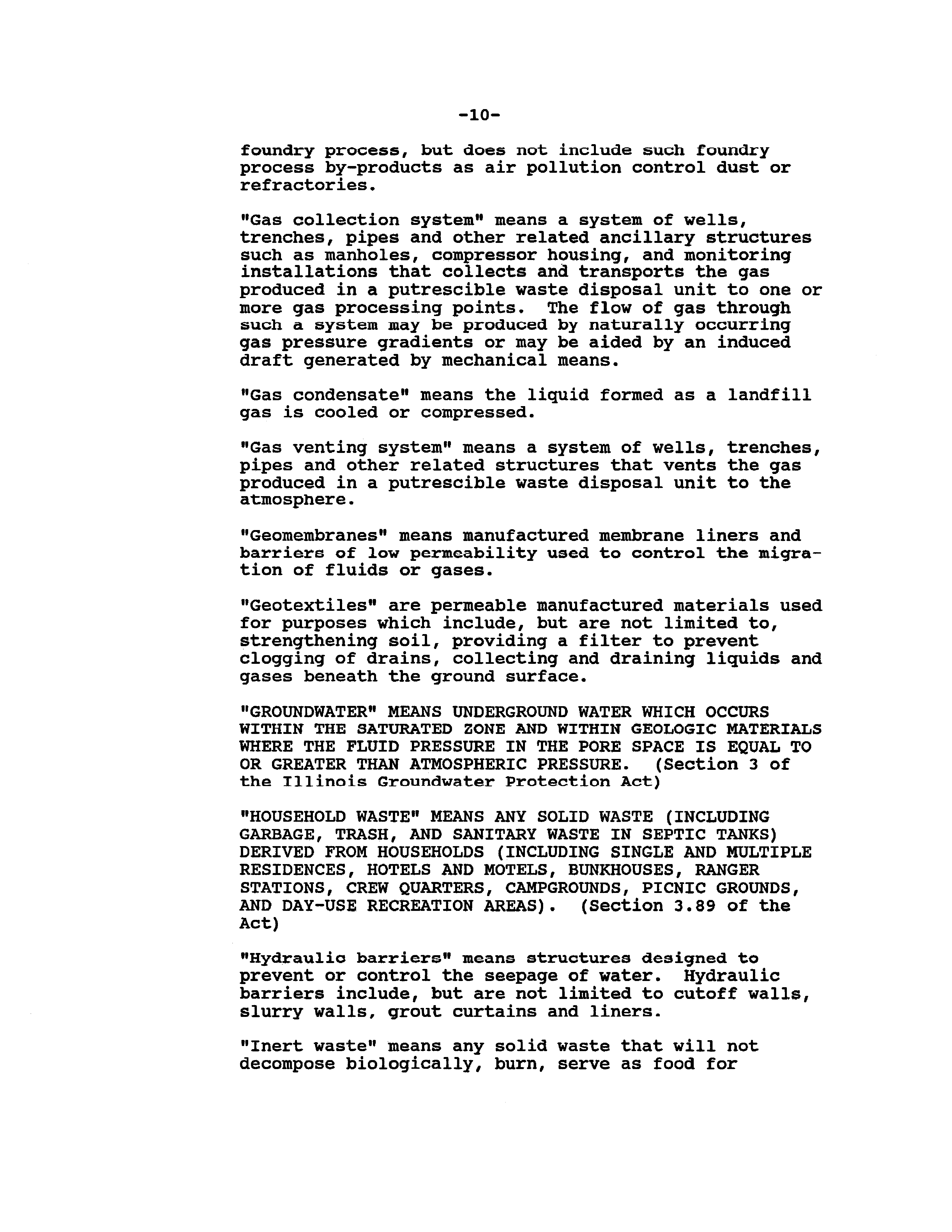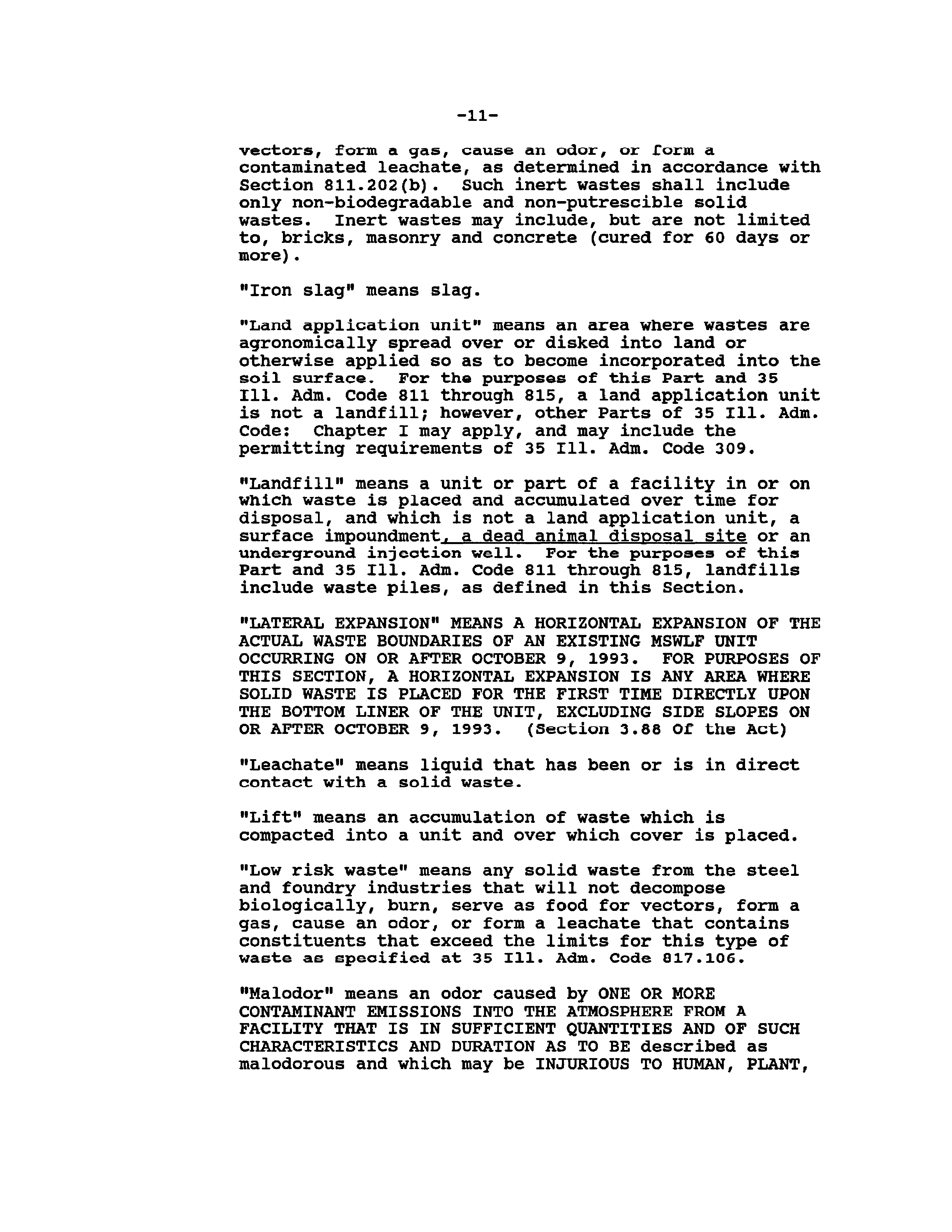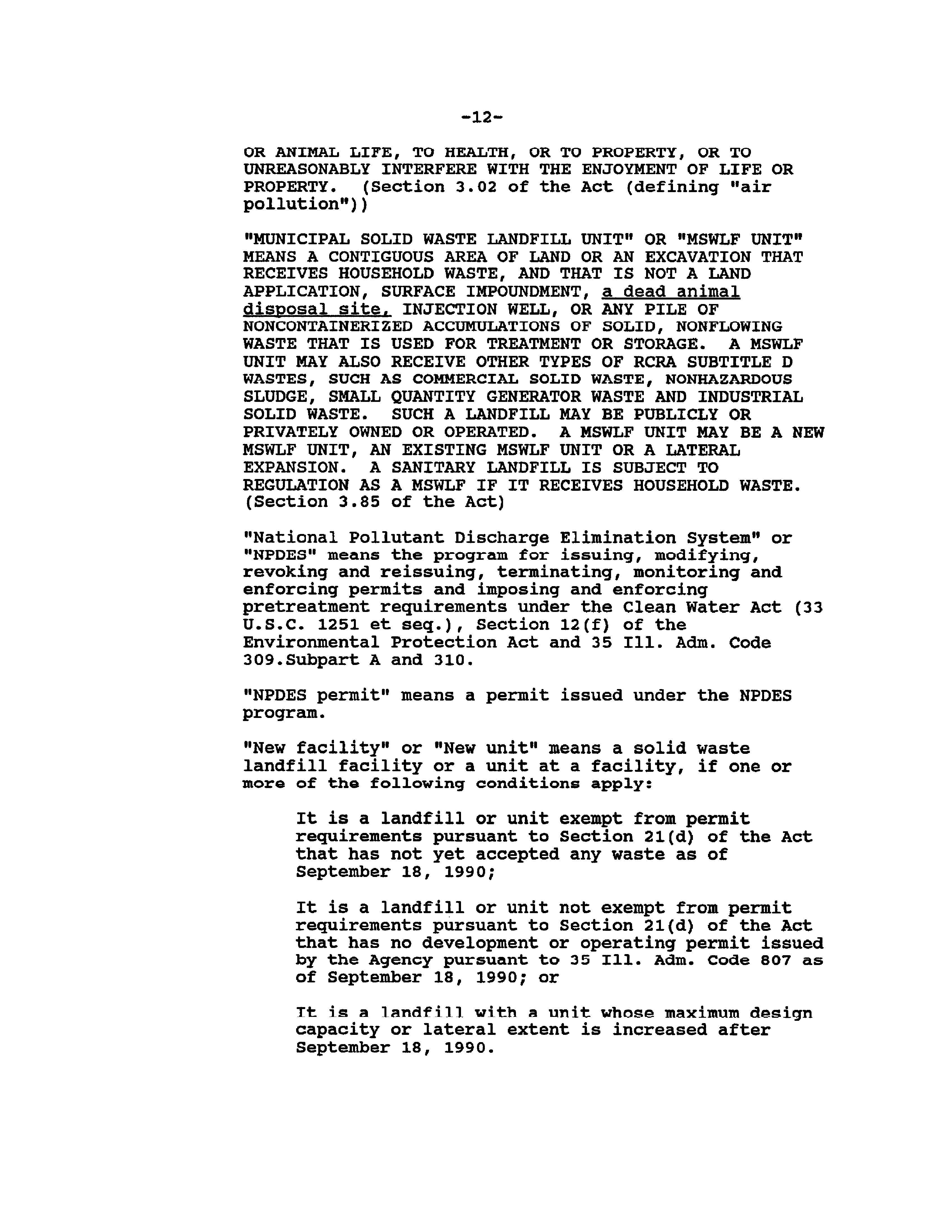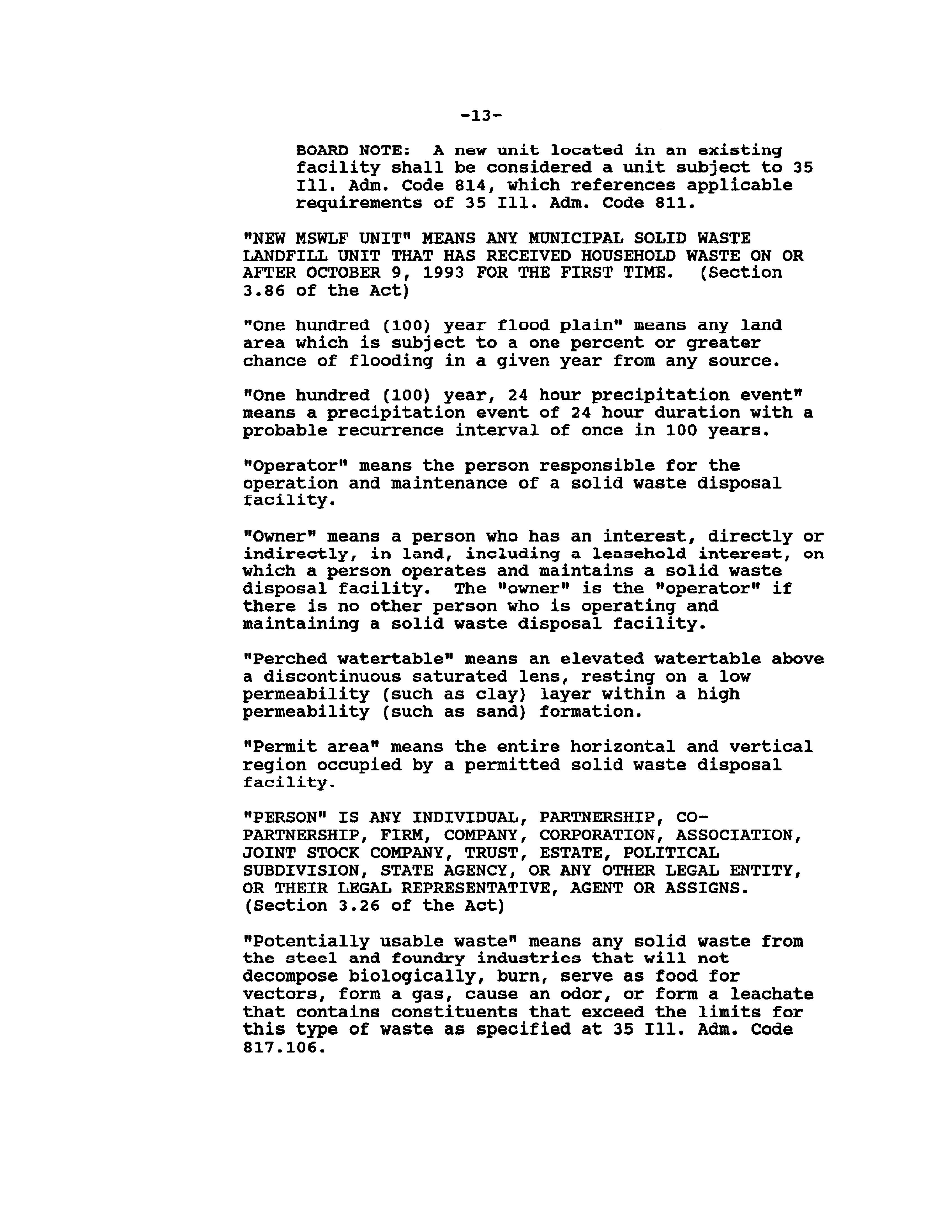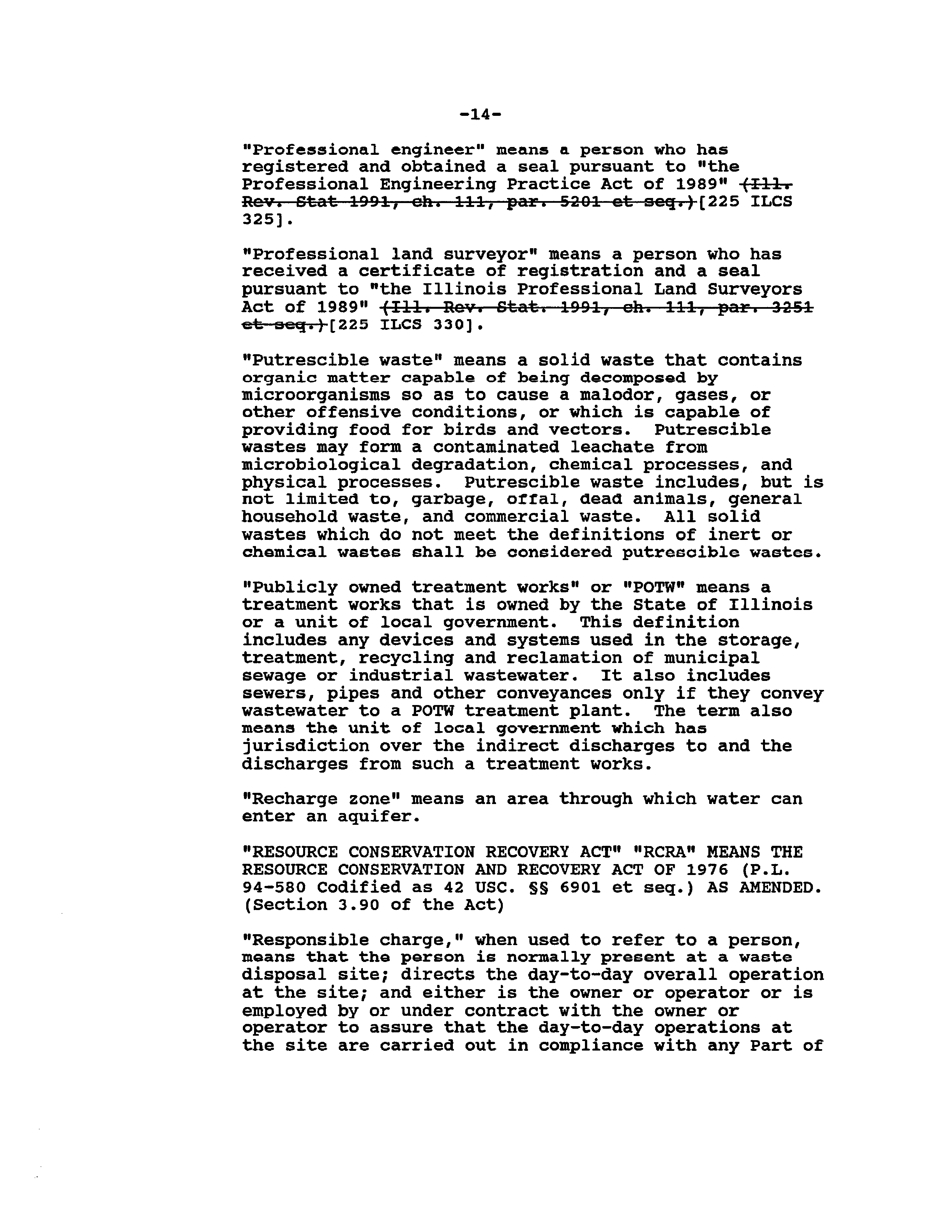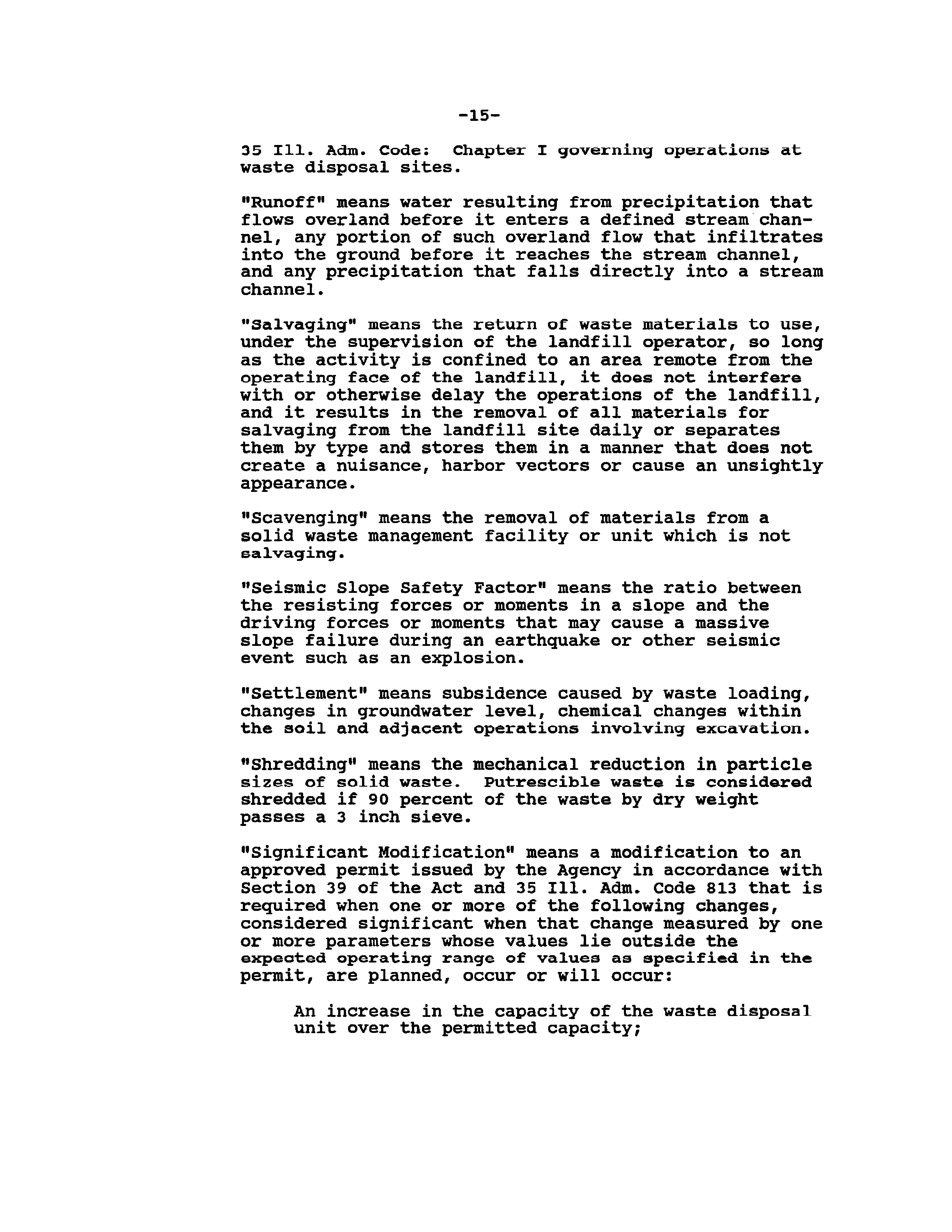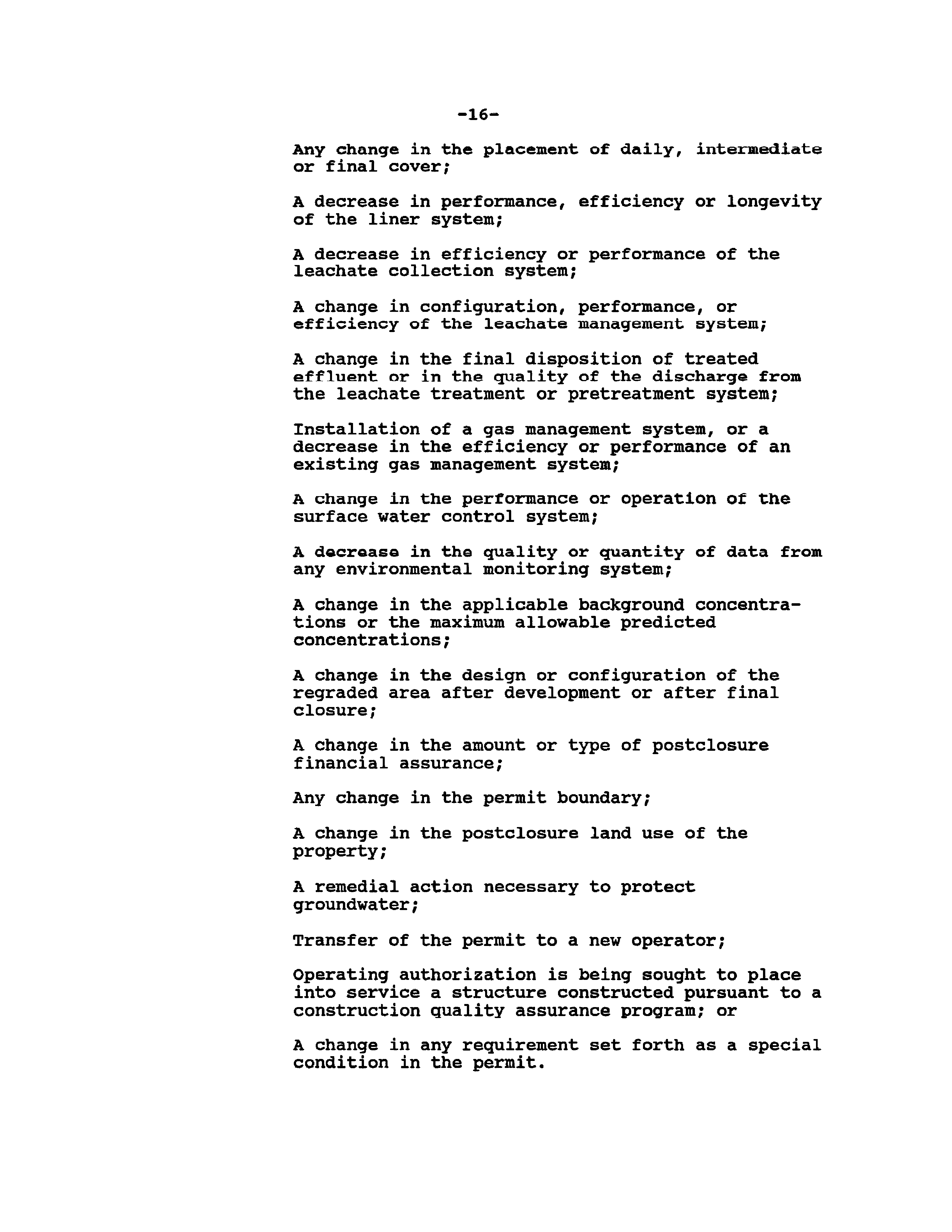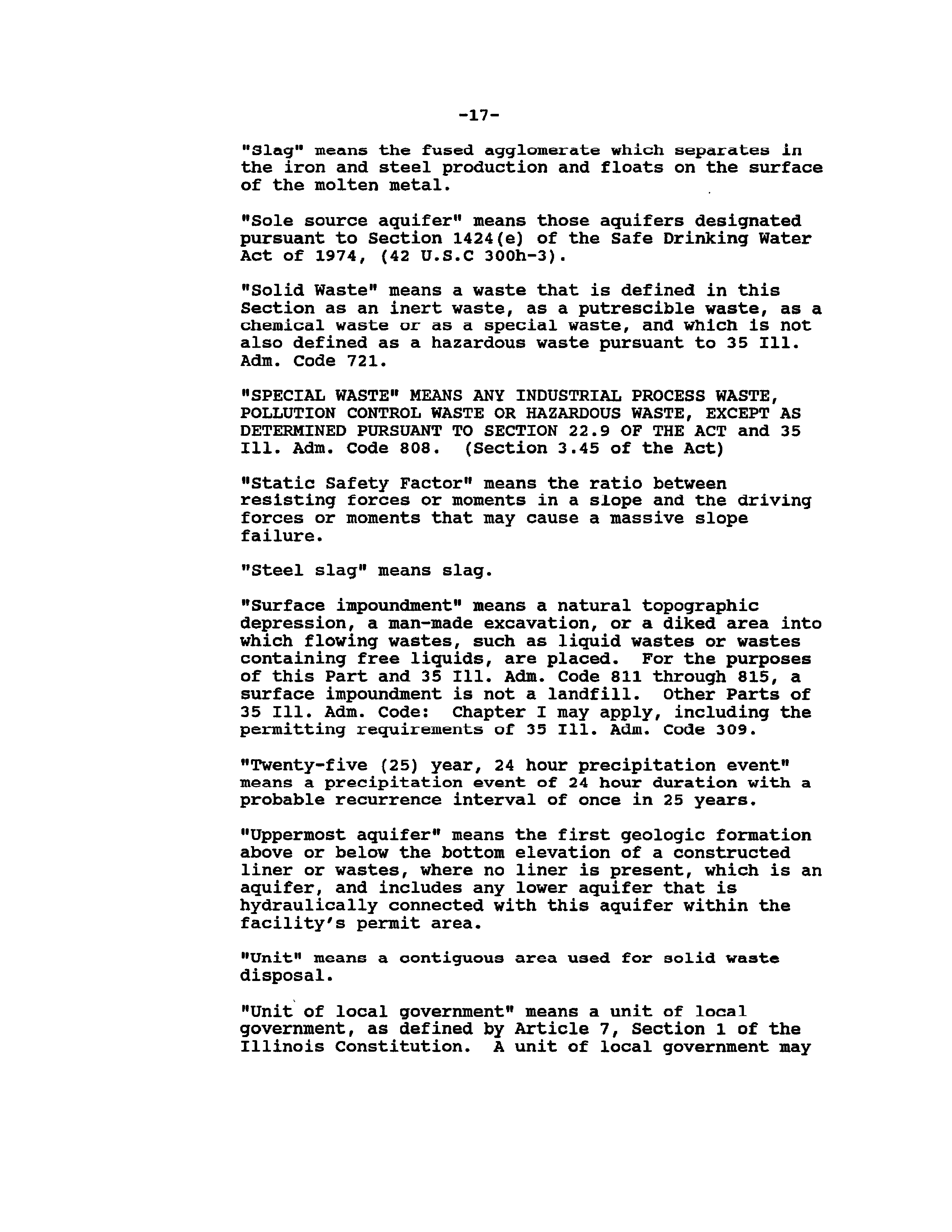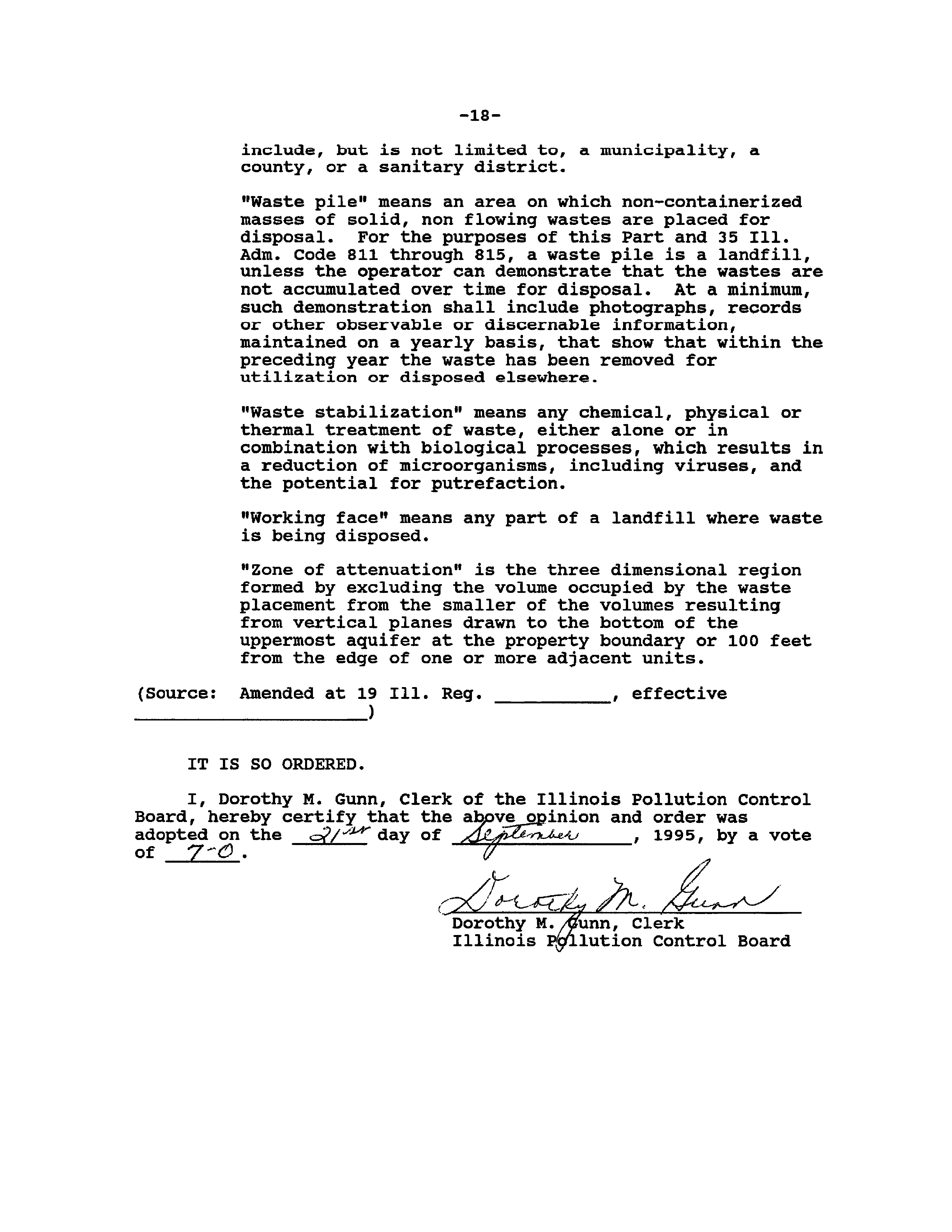ILLINOIS POLLUTION CONTROL BOARD
September 21, 1995
IN THE MATTER OF:
)
)
AMENDMENTS TO 3b
ILL. ADM.
CODE
)
R95-9
810.103
(SOLID WASTE DISPOSAL
)
(Rulemaking
-
Land)
GENERAL PROVISION)
CONCERNING
)
ON-FARM
DISPOSAL
OF
DEAD
ANIMALS
)
Adonted
Rule.
Final
Order.
OPINION AND
ORDER
OF THE BOARD
(by R.C.
Flemal):
This matter comes before the Board upon a petition to amend
the Board’s solid waste disposal regulations jointly filed by the
Illinois Fan Bureau,
Illinois Beef Association, Illinois Lamb
and Wool Producers,
Inc., Illinois Milk Producers Association,
and the Illinois Pork Producers Association (joint proponents).
The joint proponents request that the Board amended its
solid waste disposal regulations to clarify that an on-farm site
used for the burial disposal of dead animals, where the disposal
is conducted in accordance with the Illinois Dead Animal Disposal
Act
(225 ILCS 610/1 et
seq.
(1994)), does not constitute a
landfill subject to the Board’s regulations governing landfills.
The Board’s responsibility in this matter arises from the
Environmental Protection Act
(Act)
(415 ILCS 5/1 et seq.
(1994)).
The Board is charged therein to “determine, define and implement
the environmental control standards applicable in the State of
Illinois”
(415 ILCS 5/5(b)).
More generally,
the Board’s
rulemaking charge is based on the system of checks and balances
integral to Illinois environmental governance:
the Board bears
responsibility for the rulemaking and principal adjudicatory
functions; the Agency has primary responsibility for
administration of the Act and the Board’s regulations.
Today the Board adopts the amendments as final and sends the
amendments to the Administrative Code Division of the office of
Secretary of State for publication and assignment of an effective
date pursuant to Section 5 of the Illinois Administrative
Procedure Act
(S TLCS 100/S—40(d)
(1994)).
PROCEDURAL HISTORY
The joint proponents filed their proposal on February 2,
1995.
By order of February 16, 1995 the Board accepted the
proposal for hearing and granted joint proponents’ motion to
-2—
3ubatitute membership certifications
in
lieu of 200 signatures.
On February 17, 1995 the hearing officer issued an order
establishing the hearing schedule.
Hearings were held before hearing officer Audrey Lozuk-
Lawless in DeKaib on April
3,
1995 and in Springfield on April
10,
1995’.
Testimony was presented by the joint proponents, the
Illinois Environmental Protection Agency
(Agency), and the
Illinois Department of Agriculture
(Department).
The joint
proponents presented Nancy Erickson, Jack Fisher, Allan Ayes, and
Randy Sims on behalf of the Illinois
Farm
Bureau;
Roger
Brown
on
behalf of the Illinois Pork Producers Association; Kenneth McPeek
and Jim Fraley on behalf of the Illinois Milk Producers
A~sc~ciation;
Jamie Willrett and
scott Porrance on
behalf of the
Illinois Beef Association; and Joe Pickrell on behalf of the
Illinois Wool and Lamb Producers.
Dave Bateman presented
testimony on own behalf as a livestock producer.
A.G. Taylor
presented testimony
on behalf of
the Agency and Dr. David Browel.
testified on behalf of the Department.
All witnesses spoke in
support of the proposal.
By order of May 18,
1995 the Board adopted the joint
proponents proposal for purpose of first notice.
First notice
publication occurred in the
I11inoi~Regicter
Vol. 19, p.
7502,
on June 9,
1995.
The Board received three public comments
(PC) during the
post—first notice comment period, respectively from the Illinois
Beef Association, Illinois Pork Producers Association, and
Illinois Farm Bureau.
In each case, the commenters expressed
their continued support for adoption of the amendments.
By order of
August
24,
1995 the Board adopted the proposal
for
second
notice.
At its meeting on September
12,
1995 the Joint Committee on
Administrative Rules
(JCAR)
voted
no
objection to adoption of the
amendments.
However,
JCAR
recommends, and the Board accepts, two
non—substantive changes intended to eliminate surplus language.
The first is the removal of all citations to Illinois Revised
Statutes2.
The
second is elimination of the phrase “see P.A. 88-
133, effective January
1,
1994” from the definition of “dead
animal disposal site” as proposed for first and second notice.
‘
Transcripts of the two hearings are cited herein
respectively as “Tr.l” and “Tr.2”.
~ Pursuant to Public Act 87—1005, effective January
1,
1993,
the Revised Statutes have been superseded by the Official
Illinois Compiled Statutes (ILCS).
ILCS citations are already
present in the text.
—3—
OVERVIEW
The Illinois General Assembly has long recognized that
proper disposal of dead animals is a matter of public interest.
Pursuant thereto, the General Assembly has enacted, and amended
as warranted, the Illinois Dead Animal Disposal Act3.
The
Illinois Dead Animal Disposal Act is administered by the
Department.
The
disposal
of
dead
animals
is
further
governed
by
regulations adopted by the Department under authorities granted
to it in the Illinois Dead Animal Disposal Act.
These
regulations are found at 8
Ill. Adm. Code 90.
At particular issue in the instant matter are the
Department’s regulations found at
8 Ill
•
Adm. Code 90,110(b1,
which deal with on-farm disposal of
dead animals via burial.
The Board also has
various regulations governing disposal
via burial.
These occur in the Board’s solid waste management
regulations,
Including 35
Il..
Adm. Code 810 et
seq.,
that
principally govern landfills and landfilling.
The purpoQo of today’s amendments is to clarify the
relationship between the Department’s on—farm dead animal
disposal regulations and the Board’s landfill regulations.
The
purpose
is
to clarify that on-farm sites where burial disposal is
conducted in accordance with the Illinois Dead Animal Disposal
Act,
and regulations promulgated thereto, are
n~
landfills
subject also to the Board’s landfill regulations5.
The substance of the amendments consists of the addition of
one definition, and the modification of two others, at 35 Ill.
~The Illinois Dead Animal Disposal Act was originally
adopted in 1941.
It was
most
recently amended effective January
1, 1994.
~ Section 90.110 also addresses on-farm disposal via
incineration and composting.
Section 90.110 was most recently
amended effective September 16,
1994.
~The Board observes that on-farm disposal of dead animals
that
is
not conducted in accordance with the Dead Animal Disposal
Act
would
be
an
action
subject
to
enforcement
under
the
Dead
Animal Disposal Act and the Department regulations.
Moreover,
such disposal would not be exempt from regulation under the
Board’s solid waste disposal regulations, and enforcement could
also follow from that cause.
—4—
Adia.
Code 81.0.103’.
The
added definition Is for
a “dead animal
disposal site”:
“Dead animal disposal site” means an on—the—farm
disposal site at which the burial of dead animals is
done in accordance with the Illinois Dead Animal
Disposal Act, 225 ILCS 610, and regulations adopted
pursuant thereto,
8 Ill. Adm. Code 90.
The modified definitions are “landfill” and “municipal solid
waste landfill unit”.
Dead animal disposal sites are now
explicitly excluded from each of these definitions, and thereby
from regulation as either a landfill or municipal solid waste
landfill unit.
JUSTIFICATION FOR TODAY’S
AMENDMENTS
History
Need for the instant action originally arose among the joint
proponents when it was observed that the Board’s solid waste
disposal regulations allowed for a reading that on—farm disposal
of dead animals via burial might cause the Board’s landfill
regulations to come into play.
(Tr..
at 17.)
This raised
further concerns among the joint proponents that their
constituent membership might face prohibitive expenses in
complying
with
the landfill regulations,
or alternatively face
prosecution.
(Tr.1 at 17-18.)
A particular provision of the Board’s solid waste
regulations of concern to the joint petitioners is the definition
of “putrescible waste”7 at 35 Ill. Adm. Code 810.103, which
contains the statement:
Putrescible waste includes, but is not limited to,
garbage, offal, dead
animals,
general
household
waste,
and commercial waste.
(emphasis added)
Joint petitioners contend that in 1990 when the Board’s
current solid waste disposal regulations
(including the
definition of putrescible waste) were being formulated, the
livestock community was advised that the regulations were
intended to address only dead animals going into municipal
landfills.
(Tr. 1 at 17.)
The joint proponents nevertheless
believed that greater clarification was needed.
(Tr. 1 at 18.)
6
Section
810.103
houses
definitions
generally
applicable
within the Board’s solid waste disposal regulations.
‘
Putrescible waste is one of the main categories of waste
governed by the Board’s landfill regulations.
—5—
The
Initial regulatory action undertaken b~the joint
proponents was to seek amendment of the Department’s animal
disposal regulations at 8 Ill. Adm. Code 90.
(Tr.1 at 19.)
This
included putting into place the current on-farm burial
regulations at 8 Ill
•
Adm. Code 90
•
110(b).
Provisions at
90.110(b) include: restriction of burial to premises owned or
operated by the owner of the dead animal; requiring burial sites
to have a minimum of 200 or 400 foot setbacks from streams,
wells, and other water sources; requiring a minimum setback from
residences; imposition of measures to minimize disease and
nuisance vectors and soil erosion; imposition or final cover and
slope requirements; authorization of site inspection by the
Department; and limitations on the number of animals that can be
buried per site and
area over time.
The joint proponents, the Department, and the Agency all
agree that the provisions at 90.110(b) offer sufficient
environmental protection for on-farm disposal such that any
additional requirements that would flow from the Board’s solid
waste disposal regulations
(e.g., landfill permits,
liners,
leachate collection systems, groundwater monitoring) are not only
burdensome, but unnecessary.
(Tr. 1 at 26.)
Disposal Options
Death of animals
is an unwelcome but inherent element of any
livestock operation.
(Tr.1 at 31,
53; Tr.2 at 25-26.)
Annual
on-farm losses of livestock are typically 1
to 4,
depending
upon the
type
of animal and operation.
(Tr.1 at 27,
37.)
There are a number of potential options available for the
disposal of dead animals.
These include rendering,
incineration,
coinposting, off—site burial disposal, and on—site burial
disposal.
Rendering was once a principal method of disposal of dead
animals.
It was accomplished by commercial renders who provided
at—farm pickup services.
However, due to a lack of demand for
animal by—products, few renderers remain in business
(Tr.
1 at
28, 33,
62), and even these provide a service limited to only
certain types of animals and pickup opportunities (Tr.1 at 28,
41,
48; Tr.2 at 17.)
At present there is no renderer operating
out of the entire northern half of the State.
(Tr.1 at 89.)
Accordingly, disposal via rendering is of limited opportunity for
many livestock producers.
Disposal by incineration
in a permitted incinerator is
allowed by regulation, but is generally not economical.
(Tr.l at
62.)
Capitalization alone for an approvable incinerator ranges
from
$12,000 to $20,000.
(Pr.1 at 29,
32.)
In addition, there
are substantial operations costs and the need to obtain and
maintain operating permits.
(Tr.1 at 32-33; Tr.2 at 30.)
—6—
Coniposting
regulations
are
currently
under
development.
At
this
juncture,
however,
it
does
not
appear
that
composting
will
be
a
viable
disposal
mechanism
for
other
than
very
small
animals
(e.g.,
chickens, newborn pigs) and fish.
(Tr.l at 49,
63.)
Off-site burial disposal of dead livestock may be undertaken
only at penitted landfills, pursuant to the Board’s solid waste
disposal regulations.
While disposal at landfills is the
acceptable disposal method for some livestock producers,
it is
not workable for many others due to the high cost of
transportation and tipping,
as well as the refusal of many
landfills to even accept dead animals.
(Tr.l at 28,
50; Tr.2 at
18,
25.)
By elimination, the only economical and practical method of
disposal available to many producers is on—fan burial.
Moreover, on—farm burial disposal has the advantage of allowing
for timely disposal, which is an important factor in disease
control.
(Tr.1 at 31, 34; Tr.2 at 24.)
CONCLUSION
The Board believes, as the joint proponents, Department, and
Agency all contend, that on—farm burial conducted in accordance
with the Dead Animal Disposal Act and associated regulations
promulgated by the Department is environmentally sound.
The Board concludes that the many requirements demanded for
the proper construction and operation of a solid waste landfill
are unnecessary for the type
of on—farm burial disposal of
concern to the joint proponents.
The Board accordingly concludes
that it is unwarranted that properly conducted, on-fan disposal
of dead animals come under the jurisdiction or our landfill
regulations.
Accordingly, we today find that the record before us
justifies adopting the joint proponents’ proposal as a final
rule.
ORDER
The Board directs that the following amendments be submitted
to the Secretary of State for final notice pursuant to Section 5-
40 of the Illinois Administrative Procedure Act.
TITLE 35:
ENVIRONMENTAL PROTECTION
SUBTITLE
02
WASTE DISPOSAL
CHAPTER
I:
POLLUTION
CONTROL
BOARD
SUBCHAPTER
i:
SOLID
WASTE
AND
SPECIAL
WASTE
HAULING
—7—
PART
810
SOLID WASTE DISPOSAL:
GENERAL PROVISIONS
Section
810.101
Scope and Applicability
810.102
Severability
810.103
Definitions
810.104
Incorporations by Reference
AUTHORITY:
Implementing Sections 5,
21,
21.1,
22 and 22.17, and
authorized by section 2/, of the Environmental Protection Act
(tll.
Rev. Stat.
1991, oh.
111½,
pars. 1005,
1021,
1021.1,
1023,
1022.17 and 1027) j415 ILCS 5/5,
21,
21.1,
22, 22.17 and 27j.
SOURCE:
Adopted in R88—7 at
14 Ill. Req.
15838, effective
September 18,
1990; amended in R93-10 at 18 Ill.
Reg.
1268,
effective January 13,
1994; amended in R90—26 at 18 Ill. Reg.
12457, effective August 1,
1994; amended in R95—9 at
19 Ill. Req.
___________,
effective ________________________
NOTE:
Capitalization indicates statutory language.
Section 810.103
Definitions
Except as stated in this Section, or unless a different meaning
of a word or ten
is clear from the context, the definition of
words or tens
in this Part shall be the same as that applied to
the same words or tens
in the Environmental Protection Act
(Act)
(Ill.
Rev. Ctat.
1991,
oh. 111~,parc.
1001 ot. seq.)
415
ILCS
5:
“Act” means the Environmental Protection Act,
Ill. Rcv.
Ctat.
1991,
oh.
111½,
parco~—100lct. ocq 415
ILCS 5).
“Admixtures” are chemicals added to earth materials to
improve for a specific application the physical or
chemical properties of the earth materials.
Admixtures
include, but are not limited to:
lime,
cement,
bentonite and sodium silicate.
“AGENCY” IS THE ENVIRONMENTAL PROTECTION AGENCY
ESTABLISHED BY THE ENVIRONMENTAL PROTECTION ACT.
(Section 3.08 of the Act.)
“Applicant” means the person, submitting an application
to the Agency for a penit for a solid waste disposal
facility.
“AQUIFER” MEANS SATURATED
(WITH GROUNDWATER) SOILS AND
GEOLOGIC MATERIALS WHICH ARE SUFFICIENTLY PEPMEABLE TO
READILY YIELD ECONOMICALLY USEFUL QUANTITIES OF WATER
TO WELLS, SPRINGS, OR STREAMS UNDER ORDINARY HYDRAULIC
GRADIENTS and whose boundaries can be identified and
—8—
mapped from hydrogeologic data.
(Section 3 of the
Illinois Groundwater Protection Act
(Ill.
flcv.
Ctat.
1~1, ch.
111 1/2,
par.
7453)
(415 ILCS 55/3))
“Bedrock” means the solid rock formation immediately
underlying any loose superficial material such as soil,
alluvium or glacial drift.
“Beneficially usable waste” means any solid waste from
the steel and foundry industries that will not
decompose biologically, burn,
serve as food for
vectors, form a gas, cause an odor,
or form a leachate
that contains constituents that exceed the limits for
this
type
of wacte
a~
specified at 35 Ill.
Adm..
Code
817.106.
“BOARD”
IS THE POLLUTION CONTROL BOARD
ESTABLISHED BY
THE
ACT.
(Section
3.04
of
the
Act)
“Borrow area” means an area from which earthen material
is excavated for the purpose or constructing daily
cover, final cover, a liner, a gas venting system,
roadways or berms.
“Chemical waste” means a non—putrescible solid whose
characteristics are such that any contaminated leachate
is expected to be formed through chemical or physical
processes, rather than biological processes, and no gas
is expected to be formed as a result.
“Contaminated leachate” means any leachate whose
constituent violate the standards of 35 Ill.
Adin. Code
811.202.
“Dead animal disposal site” means an on-the—farm
disposal site at which the burial of dead animals is
done in ac~c~ordance
with the Iflinoi~Dead Animal
Disposal
Act.
225
ILCS
610.
and
regulations
adopted
pursuant
thereto,
8
Ill.
Adin.
Code
90.
“Design Period” means that length of time determined by
the sum of the operating life of the solid waste
landfill facility plus the postclosure care period
necessary to stabilize the waste in the units.
“DISPOSAL” MEANS THE DISCHARGE, DEPOSIT, INJECTION,
DUNPING, SPILLING, LEAKING OR PLACING OF
ANY
SOLID
WASTE
INTO
OR
ON
ANY
LAND
OR WATER OR INTO
ANY
WELL
SUCH
THAT SOLID WASTE OR
ANY
CONSTITUENT OF THE SOLID
WASTE
MAY
ENTER
THE
ENVIRONMENT BY BEING EMITTED INTO
THE AIR OR DISCHARGED INTO ANY WATERS, INCLUDING
GROUNDWATER.
(Section 3.08 of the Act.)
If the solid
waste is accumulated and not confined or contained to
—9—
prevent its entry into the environment,
or there is no
certain
plan
for its disposal elsewhere,
such
accumulation shall constitute disposal.
“Disturbed areas” means those areas within a facility
that have been physically altered during waste disposal
operations or during the construction of any part of
the facility.
“Documentation” means items,
in any tangible form,
whether directly legible or legible with the aid or any
machine or device, including but not limited to
affidavits, certificates, deeds, leases, contracts or
other binding agreements, licenses, permits,
photographs, audio or video recordings, maps,
geographic surveys, chemical and mathematical formulas
or equations, mathematical and statistical calculations
and assumptions, research papers, technical reports,
technical designs and design drawings,
stocks, bonds
and financial records, that are used to support facts
or hypotheses.
“Earth liners” means structures constructed from
naturally occurring soil material that has been
compacted to achieve a low permeability.
“Existing facility” or “Existing unit” means a facility
or unit which is not defined in this Section as a new
facility or a new unit.
“EXISTING
MSWLF
UNIT”
MEANS
ANY
MUNICIPAL SOLID WASTE
LANDFILL
UNIT
THAT
HAS
RECEIVED
HOUSEHOLD
WASTE
BEFORE
OCTOBER 9,
1993.
(Section 3.87 of the Act)
“Facility” means a site and all equipment and fixtures
on a site used to treat,
store or dispose of solid or
special wastes.
A facility
consists
of an entire solid
or special waste treatment,
storage or disposal
operation.
All structures used in connection with or
to facilitate the waste disposal operation shall be
considered a part of the facility.
A facility may
include, but is not limited to, one or more solid waste
disposal units, buildings,
treatment systems,
processing and storage operations, and monitoring sta-
tions.
“Field capacity” means that maximum moisture content of
a waste, under field conditions of temperature and
pressure, above which moisture is released by gravity
drainage.
“Foundry sand” means pure sand or a mixture of sand and
any additives necessary for use of the sand in the
—10—
foundry process, but does not include such foundry
process by—products as air pollution control dust or
refractories.
“Gas collection system” means a system of wells,
trenches, pipes and other related ancillary structures
such as manholes, compressor housing, and monitoring
installations that collects and transports the gas
produced in a putrescible waste disposal unit to one or
more gas processing points.
The flow of gas through
such a system may be produced by naturally occurring
gas pressure gradients or may be aided by an induced
draft generated by mechanical means.
“Gas condensate” means the liquid formed as a landfill
gas is cooled or compressed.
“Gas venting system” means a system of wells, trenches,
pipes and other related structures that vents the gas
produced in a putrescible waste disposal unit to the
atmosphere.
“Geomembranes” means manufactured membrane liners and
barriers of low permeability used to control the migra-
tion of fluids or gases.
“Geotextiles” are permeable manufactured materials used
for purposes which include, but are not limited to,
strengthening soil, providing a filter to prevent
clogging of drains, collecting and draining liquids and
gases beneath the ground surface.
“GROUNDWATER”
MEANS UNDERGROUND
WATER
WHICH OCCURS
WITHIN TIlE
SATURATED
ZONE
AND
WITHIN GEOLOGIC MATERIALS
WHERE
THE FLUID PRESSURE IN TEE PORE SPACE IS EQUAL TO
OR
GREATER THAN
ATMOSPHERIC PRESSURE.
(Section 3 of
the Illinois Groundwater Protection Act)
“HOUSEHOLD WASTE”
MEANS ANY
SOLID WASTE
(INCLUDING
GARBAGE, TRASH,
AND
SANITARY WASTE IN SEPTIC TANKS)
DERIVED FROM HOUSEHOLDS
(INCLUDING SINGLE
AND
MULTIPLE
RESIDENCES, HOTELS
AND
MOTELS, BUNKHOUSES,
RANGER
STATIONS,
CREW
QUARTERS, CAMPGROUNDS, PICNIC GROUNDS,
AND DAY-USE RECREATION
AREAS).
(Section 3
•
89 of the
Act)
“Hydraulic barriers” means structures designed to
prevent or control the seepage of water.
Hydraulic
barriers include, but are not limited to cutoff walls,
slurry walls, grout curtains and liners.
“Inert waste” means any solid waste that will not
decompose biologically,
burn, serve as food for
—11—
vectors, form a gas, cause an odor,
or rorm a
contaminated leachate,
as determined in accordance with
Section 811.202(b).
Such inert wastes shall include
only non—biodegradable and non—putrescible solid
wastes.
Inert wastes may include, but are not limited
to, bricks, masonry and concrete (cured for 60 days or
more).
“Iron slag” means slag.
“Land application unit” means an area where wastes are
agronomically spread over or disked into land or
otherwise applied so as to become incorporated into the
soil surface.
For the purposes of this Part and 35
Ill. Adm. Code 811 through 815, a land application unit
is not a landfill; however, other Parts of 35 Ill. Adm.
Code:
Chapter I may apply, and may include the
permitting requirements of 35 111. Mm.
Code 309.
“Landfill” means a unit or part of a facility in or on
which waste is placed and accumulated over time for
disposal, and which is not a land application unit,
a
surface impoundment1 a dead animal disposal site or an
underground injection well.
Por the purposes
of
this
Part and 35 Ill. Adm. Code 811 through 815,
landfills
include waste piles, as defined in this Section.
“LATERAL EXPANSION” MEANS A HORIZONTAL EXPANSION OF THE
ACTUAL WASTE BOUNDARIES OF AN EXISTING
MSWLP UNIT
OCCURRING ON OR AFTER OCTOBER
9,
1993.
FOR PURPOSES OF
THIS SECTION, A HORIZONTAL EXPANSION IS ANY AREA WHERE
SOLID WASTE IS PLACED FOR THE FIRST TIME DIRECTLY UPON
THE BOTTOM LINER OF THE UNIT, EXCLUDING SIDE SLOPES ON
OR AFTER OCTOBER
9,
1993.
(Section 3.88 Or the Act)
“Leachate” means liquid that has been or is in direct
contact with a solid waste.
“Lift” means an accumulation of waste which is
compacted into a unit and over which cover is placed.
“Low risk waste” means any solid waste from the steel
and foundry industries that will not decompose
biologically,
burn,
serve as food for vectors, form a
gas, cause an odor,
or form a leachate that contains
constituents that exceed the limits for this type of
waste as specified at 35 Ill.
Adm.
Code 017.106.
“Malodor” means an odor caused by ONE OR MORE
CONTAMINANT EMISSIONS
INTO THE ATMOSPHERE FROM A
FACILITY
THAT
IS IN SUFFICIENT QUANTITIES
AND
OF SUCH
CHARACTERISTICS
AND
DURATION AS TO BE described as
malodorous and which may be INJURIOUS TO HUMAN, PLANT,
—12—
OR
ANIMAL
LIFE, TO
HEALTH,
OR TO PROPERTY, OR TO
UNREASONABLY INTERFERE WITH THE ENJOYMENT OF LIFE OR
PROPERTY.
(Section 3.02 of the Act (defining “air
pollution”))
“MUNICIPAL
SOLID
WASTE
LANDFILL
UNIT”
OR
“MSWLF
UNIT”
MEANS
A CONTIGUOUS AREA OF
LAND
OR AN EXCAVATION THAT
RECEIVES HOUSEHOLD WASTE, AND THAT IS NOT A
LAND
APPLICATION, SURFACE IMPOUNDMENT,
a dead animal
disposal site. INJECTION WELL,
OR ANY PILE OF
NONCONTAINERIZED ACCUNTJLATIONS OF SOLID, NONFLOWING
WASTE THAT IS USED FOR TREATMENT OR STORAGE.
A MSWLP
UNIT MAY
ALSO RECEIVE OTHER TYPES OF
RCRA
SUBTITLE D
WASTES, SUCH AS COMMERCIAL SOLID WASTE, NONHAZARDOUS
SLUDGE, SMALL QUANTITY GENERATOR WASTE
AND
INDUSTRIAL
SOLID WASTE.
SUCH A LANDFILL
MAY
BE PUBLICLY OR
PRIVATELY OWNED OR OPERATED.
A MSWLF UNIT
MAY
BE A
NEW
MSWLF
UNIT,
AN
EXISTING
MSWLF
UNIT
OR
A
LATERAL
EXPANSION.
A
SANITARY
LANDFILL
IS
SUBJECT
TO
REGULATION AS A MSWLF IF IT RECEIVES HOUSEHOLD WASTE.
(Section 3.85 of the Act)
“National Pollutant Discharge Elimination System” or
“NPDES” means the program for issuing, modifying,
revoking and reissuing,
terminating, monitoring and
enforcing permits and imposing and enforcing
pretreatment
requirements
under
the
Clean
Water
Act
(33
U.S.C. 1251 et seq.), Section 12(f)
of the
Environmental Protection Act and 35 Ill.
Adm.
Code
309.Subpart
A
and
310.
“NPDES
permit”
means
a
permit
issued
under
the
NPDES
program.
“New facility” or “New unit” means a solid waste
landfill facility or a unit at a facility,
if one or
more of the following conditions apply:
It is a landfill or unit exempt from permit
requirements pursuant to Section 21(d) of the Act
that has not yet accepted any waste as of
September 18,
1990;
It is a landfill or unit not exempt from permit
requirements pursuant to Section 21(d) of the Act
that
has no development or operating permit issued
by the Agency pursuant to 35 Ill.
Adm. Code 807 as
of September 18,
1990; or
Tt is a landfill with a unit whose maximum design
capacity or lateral extent is increased after
September 18,
1990.
—13—
BOARD
NOTE;
A new
unit
located in an existing
facility shall be considered a unit subject to 35
Ill.
Adm. Code 814, which references applicable
requirements of 35 Ill. Adm. Code 811.
“NEW
MSWLF UNIT”
MEANS
ANY MUNICIPAL SOLID WASTE
LANDFILL
UNIT THAT HAS RECEIVED HOUSEHOLD WASTE ON OR
AFTER OCTOBER
9,
1993 FOR THE FIRST TIME.
(Section
3.86 of the Act)
“One hundred
(100)
year flood plain” means any land
area which is subject to a one percent or greater
chance of flooding in a given year from any source.
“One hundred
(100)
year, 24 hour precipitation event”
means a precipitation event of 24 hour duration with a
probable recurrence interval of once in 100 years.
“Operator” means the person responsible for the
operation
and
maintenance
of
a
solid
waste
disposal
tacility.
“Owner”
means
a
person
who
has
an
interest,
directly
or
indirectly,
in land, including a leasehold interest, on
which
a
person
operates
and
maintains
a
solid
waste
disposal facility.
The “owner” is the “operator” if
there is no other person who is operating and
maintaining a solid waste disposal facility.
“Perched watertable” means an elevated watertable above
a discontinuous saturated lens, resting on a low
permeability (such as clay)
layer within a high
permeability (such as sand)
formation.
“Permit
area” means the entire horizontal and vertical
region occupied by a permitted solid waste disposal
facility.
“PERSON” IS
ANY
INDIVIDUAL,
PARTNERSHIP,
CO-
PARTNERSHIP, FIRM,
COMPANY, CORPORATION, ASSOCIATION,
JOINT STOCK COMPANY, TRUST, ESTATE, POLITICAL
SUBDIVISION, STATE AGENCY, OR ANY OTHER LEGAL ENTITY,
OR THEIR LEGAL REPRESENTATIVE, AGENT OR ASSIGNS.
(Section 3.26 of the Act)
“Potentially usable waste” means any solid waste from
the steel and foundry industries that will not
decompose biologically, burn,
serve as food for
vectors, form a gas, cause an odor,
or form a leachate
that contains constituents that exceed the limits for
this type of waste as specified at 35 Ill.
Adm. Code
817.106.
—14—
“Professional engineer” means a person who has
registered and obtained a seal pursuant to “the
Professional Engineering Practice Act of 1989”
(Ill-.-ET?1 w?477 667 m?508 667 l?S?BT?
Rev. Stat 1991,
oh. 111, par.
5201 et seq.-) (225 ILCS
325.
“Professional land surveyor” means a person who has
received a certificate of registration and a seal
pursuant to “the Illinois Professional Land Surveyors
Act of 1989”
(Ill. Rev—Stat.
1991,
oh.
111,
par.
3251
ct scg.)~225 ILCS 330.
“Putrescible waste” means a solid waste that contains
organic matter capable
of
being decomposed by
microorganisms so as to cause a malodor, gases,
or
other offensive conditions, or which is capable of
providing food for birds and vectors.
Putrescible
wastes may form a contaminated leachate from
microbiological degradation, chemical processes, and
physical processes.
Putrescible waste includes, but is
not limited to, garbage, orral, dead animals, general
household waste, and commercial waste.
All solid
wastes which do not meet the definitions of inert or
chemical wastes shall be considered putrescible wastes.
“Publicly owned treatment works” or
“POTW”
means a
treatment works that is owned by the State of Illinois
or a unit of local government.
This definition
includes any devices and systems used in the storage,
treatment, recycling and reclamation of municipal
sewage
or
industrial
wastewater.
It
also
includes
sewers, pipes and other conveyances only if they convey
wastewater to a POTW treatment plant.
The term also
means the unit of local government which has
jurisdiction over the indirect discharges to and the
discharges from such a treatment works.
“Recharge zone” means an area through which water can
enter an aquifer.
“RESOURCE CONSERVATION RECOVERY ACT” “RCRA” MEANS THE
RESOURCE CONSERVATION AND RECOVERY ACT OF 1976
(P.L.
94—580 Codified as 42 USC.
if 6901 et seq.)
AS
AMENDED.
(Section 3.90 of the Act)
“Responsible charge,” when used to refer to a person,
means that the person is normally present at a waste
disposal site; directs the day-to-day overall operation
at the site; and either is the owner or operator or is
employed by or under contract with the owner or
operator to assure that the day—to—day operations at
the site are carried out in compliance with any Part of
—15—
35
Ill. Adm. Code;
chapter
I governing operations at
waste disposal sites.
“Runoff” means water resulting from precipitation that
flows overland before it enters a defined stream~chan-
nel, any portion of such overland flow that infiltrates
into the ground before it reaches the stream channel,
and any precipitation that falls directly into a stream
channel.
“Salvaging” means the return of waste materials to use,
under the supervision of the landfill operator,
so long
as the activity is confined to an area remote from the
operating face of the landfill,
it does not interfere
with or otherwise delay the operations of the landfill,
and it results in the removal of all materials for
salvaging from the landfill site daily or separates
them by type and stores them in a manner that does not
create a nuisance, harbor vectors or cause an unsightly
appearance.
“Scavenging” means the removal of materials from a
solid waste management facility or unit which is not
salvaging.
“Seismic Slope Safety Factor” means the ratio between
the resisting forces or moments in a slope and the
driving forces or moments that may cause a massive
slope failure during an earthquake or other seismic
event such as
an explosion.
“Settlement” means subsidence caused by waste loading,
changes in groundwater level, chemical changes within
the soil and adjacent operations involving excavation.
“Shredding” means the mechanical reduction in particle
sizes of solid waste.
Putrescible waste is considered
shredded if 90 percent of the waste by dry weight
passes a 3 inch sieve.
“Significant Modification” means a modification to an
approved permit issued by the Agency in accordance with
Section 39 of the Act and 35 Ill. Adm. Code 813 that is
required when one or more of the following changes,
considered significant when that change measured by one
or more parameters whose values lie outside the
expected operating range of
values as specified in the
permit, are planned, occur or will occur:
An increase in the capacity of the waste disposal
unit over the permitted capacity;
—16—
Any
change in the placement of daily, intermediate
or final cover;
A decrease in performance, efficiency or longevity
of the liner system;
A decrease in efficiency or performance of the
leachate collection system;
A change in configuration, performance,
or
efficiency of the leachate management system;
A change in the final disposition of treated
effluent or in the quality of the discharge from
the leachate treatment or pretreatment system;
Installation of a gas management system,
or a
decrease in the efficiency or performance of an
existing gas management system;
A change in the performance or operation of tne
surface water control system;
A decrease in the quality or quantity of data from
any environmental monitoring system;
A change in the applicable background concentra-
tions or the maximum allowable predicted
concentrations;
A change in the design or configuration of the
regraded
area
after
development
or
after
final
closure;
A change in the amount or
type
of
postclosure
financial assurance;
Any change in the permit boundary;
A change in the postclosure land use of the
property;
A remedial action necessary to protect
groundwater;
Transfer of the permit to a new operator;
Operating authorization is being sought to place
into service a structure constructed pursuant to a
construction
quality
assurance
program;
or
A change in any requirement set forth as a special
condition in the permit.
-17-
“Slag” means the fused agglomerate which separates in
the
iron and steel production and floats on the surface
of the molten metal.
“Sole source aquifer” means those aquifers designated
pursuant to Section 1424(e)
of the Safe Drinking Water
Act of 1974,
(42 U.S.C 300h—3).
“Solid Waste” means a waste that is defined in this
Section as an inert waste,
as a putrescible waste,
as
a
chemical waste or as a special waste, and which is not
also defined as a hazardous waste pursuant to 35 Ill.
Adm. Code 721.
“SPECIAL WASTE” MEANS
ANY
INDUSTRIAL PROCESS WASTE,
POLLUTION CONTROL WASTE OR HAZARDOUS WASTE, EXCEPT AS
DETERMINED PURSUANT TO SECTION 22.9 OF THE ACT and 35
Ill. Adm. Code 808.
(Section 3.45 of the Act)
“Static Safety Factor” means the ratio between
resisting forces or moments in a slope and the driving
forces or moments that may cause a massive slope
failure.
“Steel slag” means slag.
“Surface impoundment” means a natural topographic
depression, a man—made excavation, or a diked area into
which flowing wastes, such as liquid wastes or wastes
containing free liquids, are placed.
For the purposes
of this Part and 35 Ill.
Adm.
Code 811 through 815, a
surface impoundment is not a landfill.
Other Parts of
35 Ill. Adm.
Code:
Chapter I may apply, including the
permitting
requirements
of
35
Ill.
AWn.
Code 309.
“Twenty-five
(25) year,
24 hour precipitation event”
means a precipitation event of 24 hour duration
with a
probable recurrence interval of once in 25 years.
“Uppermost aquifer” means the first geologic formation
above or below the bottom elevation of a constructed
liner or wastes, where no liner is present, which is an
aquifer, and includes any lower aquifer that is
hydraulically connected with this aquifer within the
facility’s permit area.
~
means a contiguous area used for solid waste
disposal.
“Unit
of
local
government”
means
a
unit
of
local
government,
as defined by Article
7,
Section 1 of the
Illinois Constitution.
A unit of local government may
—18—
include, but
is
not limited
to,
a municipality,
a
county, or a sanitary district.
“Waste pile” means an area on which non—containerized
masses of solid, non flowing wastes are placed for
disposal.
For the purposes of this Part and 35 Ill.
Adm. Code 811 through 815, a waste pile is a landfill,
unless the operator can demonstrate that the wastes are
not accumulated over time for disposal.
At a minimum,
such demonstration shall include photographs, records
or other observable or discernable information,
maintained on a yearly basis, that show that within the
preceding year the waste has been removed for
utilization or disposed elsewhere.
“Waste
stabilization” means any chemical, physical or
thermal treatment of waste, either alone or in
combination with biological processes,
which results in
a reduction of microorganisms, including viruses, and
the potential for putrefaction.
“Working face” means any part of
a landfill where waste
is being disposed.
“Zone of attenuation” is the three dimensional region
formed by excluding the volume occupied by the waste
placement from the smaller of the volumes resulting
from vertical planes drawn to the bottom of the
uppermost aquifer at the property boundary or 100 feet
from the edge of one or more adjacent units.
(Source:
Amended at 19 Ill.
Reg.
__________,
effective
IT IS SO ORDERED.
I, Dorothy M. Gunn,
Clerk of the Illinois Pollution Control
Board, hereby certify that the ab ye o .inion and order was
adopted onthe
~Q/-’~day
of
_____________,
1995, by a vote
(76~L~4
~,
Dorothy M. 4unn,
Clerk
Illinois P&lflution Control Board
